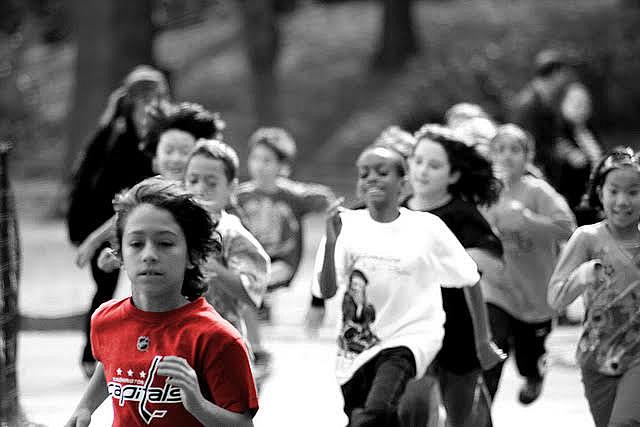All the world's a game for newer programs that aim to get kids moving

Given the convulsions rocking the health policy landscape these days, there hasn’t been a lot of leftover media bandwidth for the deeper drivers of health — the forces that can help shape whether people get debilitating chronic conditions in the first place.
So it’s worth pausing to remember that health is more than policy decisions made in Washington, D.C., or Austin or Sacramento. Healthy food, exercise, safe communities, education — all these “upstream” drivers of health matter more than ever, given rising rates of chronic disease and skyrocketing health care costs.
Making progress on these is famously hard. But when it comes to kids, there’s been a growing effort in recent years to boost physical activity and curb obesity by turning exercise into a game. You might say that’s just new dressing on an old idea called “sports,” but the newer approaches owe more to the idea of “gamification” and behavioral psychology than, say, an old-fashioned game of pickup in the park.
Take it from someone who once hawked Christmas ornaments to every house on his block in exchange for the paltriest of school prizes: Kids are extraordinarily susceptible to modest incentives. And the ubiquity of smartphones and online games nowadays gives parents and educators a whole new arsenal of high-tech nudges and carrots to prod kids off the couch. Playing Pokémon Go may not hold a candle to the calories burned during an average game of tag, but it’s still quite a few steps ahead of the Xbox.
For example, in the struggling community of Patricroft outside Manchester, England, “going fobbing” is all the rage. Kids scurry around town swiping fobs against sensors on lampposts, racking up points as they go, with dozens of schools and community groups taking part. It’s part of a larger UK program called Beat the Street, which “turns a town into a game where people earn points as they walk, cycle and run around.” In a story for the Guardian, journalist Rachel Pugh shares this breathless testimony from a local school sports coach:
I’ve never known anything like it — children are going out walking every evening and weekend. Teaching assistants take the children out at lunchtime three times a week and take whole classes out twice a week. I’ve had parents telling me how happy they are to be spending time with their children going fobbing rather than sitting in front of the TV.
But such incentive-based programs don’t have to rest on technology. In South Carolina’s Greenville County, where nearly 36 percent of young people are overweight or obese, researchers recently tested out a program that used a summer-long scavenger hunt as a way to encourage kids to get active and visit parks more often.
Built on CDC guidelines for increasing a community’s physical activity level, the Park Hop program spread “clues” throughout 19 parks throughout the county (for example, “How many frog stencils did you count on the trail?”) Participants used the clues to fill out “park passports” and win prizes such as a t-shirt or tickets to a ballgame, based on how many clues they followed successfully.
In new findings published by the CDC, researchers found that the share of time spent doing physical activity increased 10 percent among participants, and two of the Park Hop parks had nearly 300 more children and teens visit than two other parks used as controls. Kids visited an average of 12 participating parks over the summer. The low-cost program “positively influenced park usage, park discovery, time engaged in physical activity during park visits and perceptions of parks,” the study concluded.
One of the interesting things about these approaches to boosting activity is that they’re built on some basic behavioral psychology: Put the focus on fun first, and physical activity will accrue as a useful side effect. Every kid labors under the tedium of two laps on the track, while the two miles of ground covered during hike-and-seek is hardly noticed.
Whether the “gamification of health care” can meaningfully reverse the sedentary pull of our hyper-digital present is an open question. These examples don’t say much about the potential of such programs to scale, or whether such short-term incentives are merely the exercise equivalent of dieting. A 2015 review of 10 studies on the impact of incentives on exercise found they “tended to improve behavior during the intervention, while findings were mixed regarding sustained behavior after incentives were removed.”
But to the extent that these programs appear to be getting kids outside in newly kinetic ways, that’s a win. We could all use a few more carrots to goad us into motion.
[Photo by United Themes via Flickr.]

